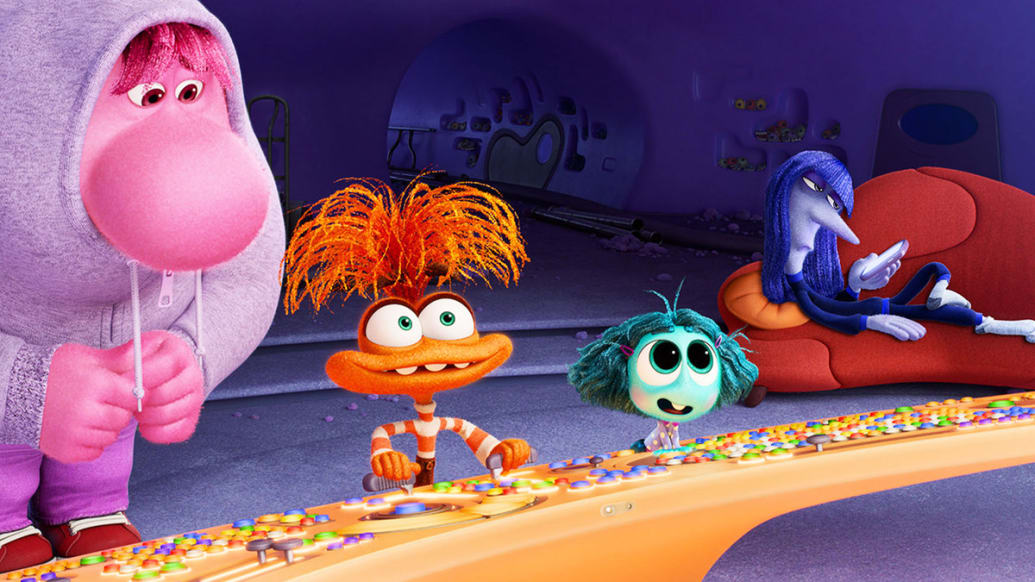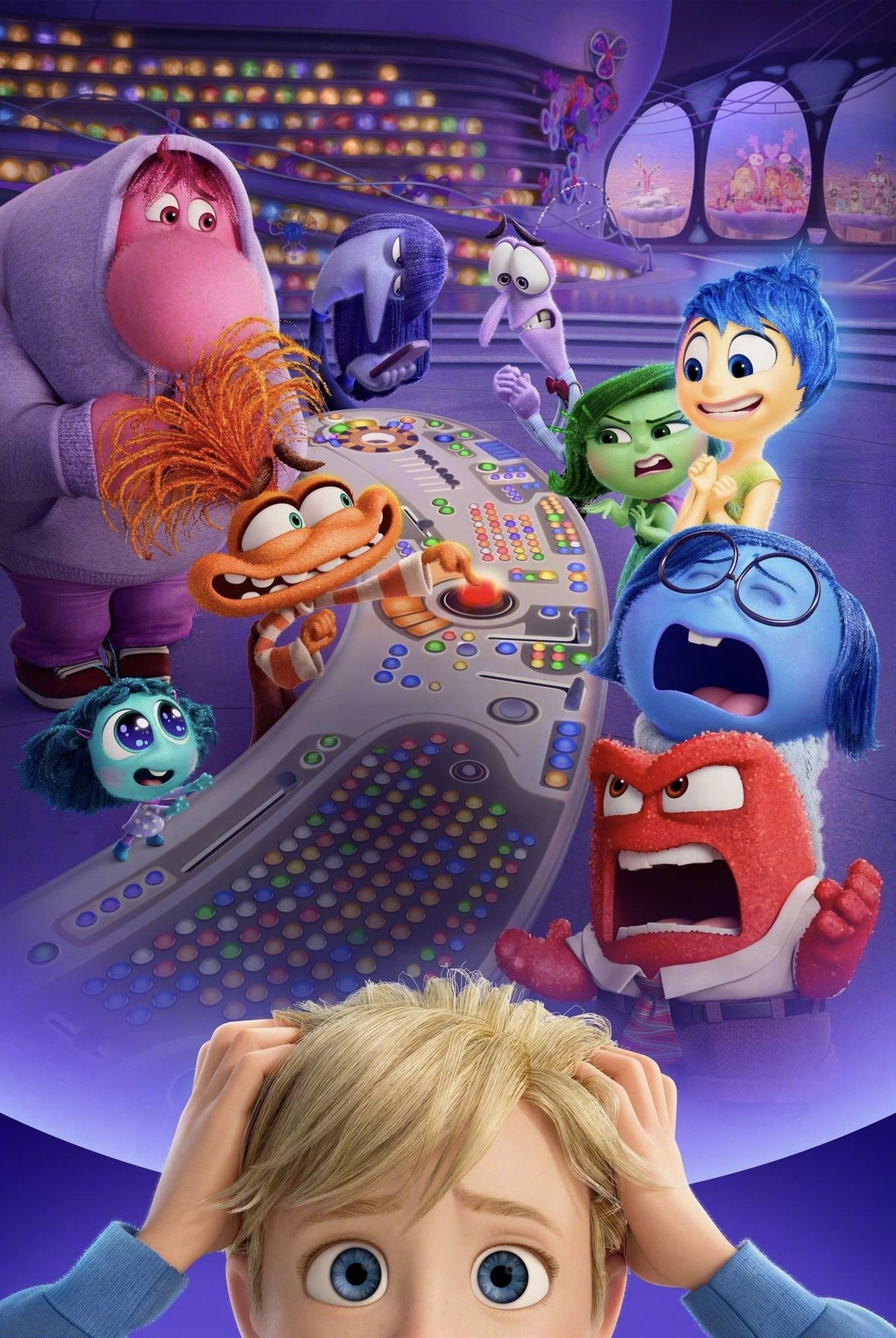Growing up is never easy, and for Riley, who is now 13, the journey through adolescence is a whirlwind of new experiences and emotions. Inside Out 2 beautifully captures this complex phase of life, opening a window into the emotional roller coaster that comes with it.

The new emotions in Inside Out 2 – Disney/Pixar
As Riley transitions into her teenage years, four new emotions—Anxiety, Envy, Embarrassment, and Ennui—make their debut in her mental Headquarters. These new emotions join the core group of Joy, Sadness, Fear, Disgust, and Anger, each adding their unique touch to Riley’s evolving personality and behaviour.
Through Riley’s eyes, we witness the highs and lows of adolescence, a time filled with both excitement and uncertainty. When Riley faces a crisis, these new emotions take control, pushing the familiar ones to the back of her mind and creating a dynamic interplay within her thoughts and behaviours.
The Complex Landscape of Emotions
Inside Out 2 brilliantly showcases the complexity of the emotions we can experience by personifying them and illustrating how they interact within Riley’s mind. This portrayal not only makes the abstract concept of emotions accessible but also emphasises that every emotion has a role to play in our lives.
It’s not easy for many of us to put our emotions into words. Understanding the difference between thoughts and feelings is important. Therapy often helps people talk about what they feel. By understanding and naming our emotions, we can begin to make sense of them and recognise the messages they have for us. How else could we learn to manage a situation without first understanding it?
What Inside Out 2 manages to do is to provide an easier way of describing and understanding emotions. The new emotions Riley starts to experience, although often perceived negatively, are shown to have protective and growth-promoting functions.
Understanding and Accepting All Emotions
One of the most important lessons from Inside Out 2 is that all emotions, even the uncomfortable ones, are valuable. Each one serves a purpose and contributes to our overall well-being. Anxiety, for instance, is often seen as a negative character, but in Inside Out 2, it is portrayed as a protector, although rushed most of the time and not knowing exactly how to deal with things. This perspective aligns with the therapeutic approach of recognising and managing anxiety rather than trying to eliminate it. Anxiety helps us anticipate potential threats and make better decisions, but it needs to be kept in balance to avoid overwhelming us.
Inside Out 2 goes beyond simply introducing new emotions; it explores the interplay between them. The film highlights that emotions often coexist and interact in complex ways, leading to confusion and difficulty in identification and expression. My favourite part was the relationship between Embarrassment and Sadness which is particularly engaging, illustrating how these emotions can influence each other and Riley’s overall sense of self.
The film’s message about mental health and self-acceptance is clear. Instead of aiming for only positive feelings, Riley learns to accept herself with all her strengths and weaknesses, recognising that she can be kind and brave, yet still make mistakes at times.
Developing Emotional Awareness
When Riley’s Anxiety takes over, it attempts to construct a new identity for her based solely on fear and self-doubt. However, this leads to a harmful self-perception that needs to be reconciled with her other emotions. The resolution comes when all emotions work together, creating a more nuanced and honest self-understanding that embraces both strengths and weaknesses.
This process of self-discovery is crucial for teenagers, who are in a pivotal stage of identity formation. By watching Riley’s journey, viewers—both young and old—can gain insights into their own emotional experiences and the importance of accepting all parts of themselves. The film shows that mental health and self-worth come from acknowledging our full range of emotions and behaviours, not just the positive ones.
The New Emotions
Each new emotion in Inside Out 2 plays a big role in Riley’s life:
Anxiety: Often viewed as a negative emotion, in the film it’s shown as a protector, watching out for Riley’s safety by making her aware of possible threats and making better decisions. She explains to the five basic emotions that “we all have a job to do” – and hers is to “plan for the future”.
Envy: Driven by a fear of missing out rather than a desire to harm others, envy motivates Riley to achieve and strive for what she perceives others to have.
Embarrassment: A social emotion that becomes prominent as Riley becomes more aware of how others perceive her, embarrassment helps her navigate social dynamics and develop self-awareness.
Ennui: Ennui represents a sense of boredom and lack of mental stimulation, common in teenagers. Using a French accent, she uses sarcastic phrases, embodying teenage indifference. Ennui controls Riley’s emotions using her smartphone as a remote, without ever getting up from the sofa.
Understanding Anxiety
Anxiety is a key focus in the film, not as a bad guy but as someone trying to help. This reflects real-life therapy, where anxiety is seen as protective. The film shows how anxiety, when balanced with other feelings, helps Riley handle challenges and remember important things, like studying for a test.
Furthermore, an important moment in the film is the Riley experiences a panic attack. This scene is incredibly powerful, vividly showing how overwhelming and intense it can feel.
Anxiety’s actions, though fast and frantic, come from a desire to protect Riley, showing the complexity of this emotion.

Photo Credits to Disney/Pixar
An Excellent Tool for Emotional Education
Inside Out 2 is a great way to start talking about emotions, self-awareness, and mental health. It makes us think about our own emotions and how we deal with them. It emphasises that emotions shouldn’t be suppressed or ignored but understood, accepted and integrated as part of who we are.
Conclusion: Why Inside Out 2 is Worth Watching
Inside Out 2 captures the complex emotional journey of adolescence with clarity and insight. This sequel teaches us a wonderful lesson: every emotion plays an important role in our lives and should be acknowledged, not ignored. By embracing both positive and challenging emotions with empathy and understanding, we not only enhance our own emotional well-being but also strengthen our connections with others.
I watched the film with my son, who is 8, at the cinema, and he was captivated throughout. He asked many questions about all the characters, especially Anxiety and Embarrassment, admitting he has experienced these emotions himself a few times. This opened up a whole conversation about emotions, allowing me to learn so many new things about his internal world.
Watching Inside Out 2 isn’t just about enjoying another remarkable Pixar film. With its deep insights into the nature of emotions, it offers a great perspective on what adolescence means, emotional intelligence, and personal growth, appealing to audiences of all ages.
Best Quotes
Some of the best quotes from Inside Out 2 in my opinion are:
Riley: “I’m a good person.”
Joy: “Maybe this is what happens when you grow up. You feel less joy.”
Joy: “Delusional? Of course I’m delusional! Do you know how hard is to stay positive all the time?”
Fear: “We are suppressed emotions!”
Anxiety: “Oh my Gosh! I’m Anxiety. Where can I put my stuff?”
Anxiety: “My job is to protect her from the scary stuff she can’t see. I plan for the future.”